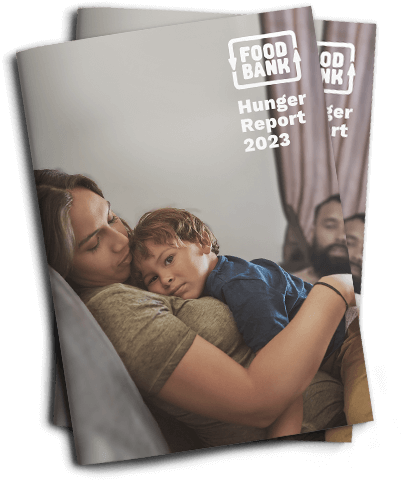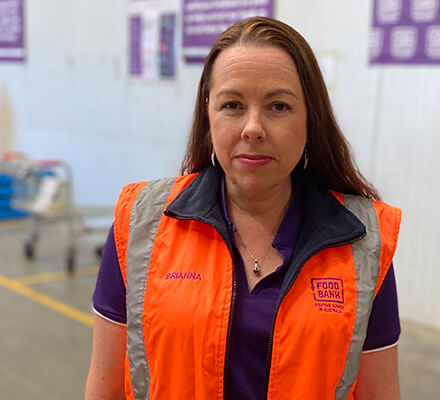
Why food security matters to everyone
“This year’s report highlights just how many households are experiencing food insecurity for the very first time, and how reluctant these people are to ask for help, despite how urgently they need food relief. It’s clear the cost-of-living crisis is exacerbating the challenges facing those in vulnerable circumstances, and forcing people to make compromises on what and when they are eating.”
A message from Brianna Casey, Foodbank Australia CEOWhat is food insecurity? Let’s put it in real terms. Food insecurity is waking early and sending your child off to school with a rumbling tummy and empty lunchbox because you’ve been forced into an impossible choice between paying the rent or buying food that week. Food insecurity is living at home alone as a pensioner, convincing yourself that three meals a day is a luxury, and that two – or even one – will suffice. Food insecurity is rushing to the fruit platter at a working lunch in the office because fresh fruit and vegetables have become a treat, rather than a dietary staple. Food insecurity is now having a mortgage, a full-time job and a side hustle, yet food is a discretionary spend in the household budget.
I wish these were hypothetical examples. They’re not.
Each year, the Foodbank Hunger Report gives us insights into food insecurity in Australia. To use the formal definition, “A person is food insecure when they lack regular access to enough safe and nutritious food for normal growth and development and an active and healthy life. This may be due to unavailability of food and/or lack of resources to obtain food”.
This year’s report highlights just how many households are experiencing food insecurity for the very first time, and how reluctant these people are to ask for help, despite how urgently they need food relief. It’s clear the cost-of-living crisis is exacerbating the challenges facing those in vulnerable circumstances, and forcing people to make compromises on what, and when they are eating. We are fast heading towards a reality where more than half the population will know what food insecurity is because they are experiencing it themselves. Add to that, natural disasters of increasing frequency and severity, and it equals an increase in the demand for food relief that has never been greater.
Our country produces enough food to feed our population three times over. We must do better to ensure nutritious, culturally appropriate food reaches the dinner tables of everyone in Australia.
Brianna Casey
Foodbank Australia CEO
Close panel
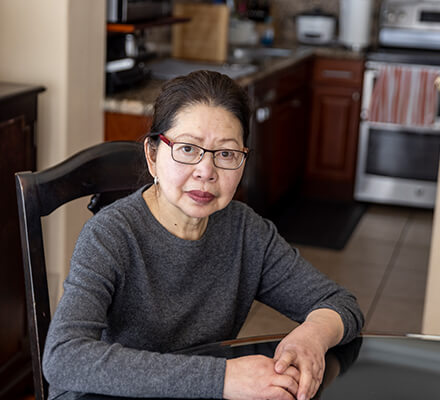
3.7 million households in Australia experienced food insecurity in the last 12 months. That’s more than the number of households in Sydney and Melbourne combined.
“I can manage to maintain just enough money to cover myself for the next meal, but all it takes is for one unexpected direct debit or sudden, urgent expense to present itself for this thin safety net to snap and fail.”
In the past year, 3.7 million Australian households (36%) experienced moderate to severe food insecurity
This means, at the very least, they are reducing the quality, variety or desirability of their food and at worst, their eating patterns are disrupted.
In the past year, 3.7 million Australian households (36%) experienced moderate to severe food insecurity, meaning – at the very least – they are reducing the quality, variety or desirability of their food and at worst, their eating patterns are disrupted.
This is more than a 10% increase on the number of households that were food insecure in 2022 or 383,000 more households which were forced to make unenviable choices about what and when they eat.
More than 2.3 million of all households (23%) fall into the category of severely `food insecure’, which means they are actively going hungry – reducing their food intake, skipping meals or going entire days without eating.
Australia is in the midst of a food security crisis where 48% of the general population now feels anxious or struggles to consistently access adequate food. This is up from 45% in 2022 and, if this trend continues, by the end of 2023 we face the reality of more than half of the general Australian population having experienced some level of difficulty in meeting the most basic of need – food.
Close panel

Food insecurity is now being experienced in homes it has never touched before
“We moved into our own house and interest rates went up at the same time. My partner has just started a business and I started in a new job. Outgoings are simply more than incomings.”
Number of households moving in and out of food insecurity
77% of those households experiencing food insecurity did so for the first time last year.
Food insecurity is now affecting households that have never been touched by it before. In the last 12 months, 77% of those households experiencing food insecurity did so for the first time last year. For the majority of those, the experience was intermittent and brief as they struggled to manage their budget in the midst of a cost-of-living crisis. While for a few, it was due to an unexpected event such as the loss of their job or unanticipated medical bills – the more common reasons cited prior to the pandemic.
Food insecurity is not experienced by everyone in the same way. To better understand this, Foodbank has developed a framework based on two key factors – the frequency and length of food insecurity episodes. Food insecure households are grouped to reflect the continuum from crisis (infrequent and short-lived food insecurity) to chronic (ever-present food insecurity).
Being at the crisis end of food insecurity is generally triggered by a community-wide or individual shock, such as a natural disaster or family breakdown. Households in these circumstances often do not see themselves as food insecure, rather they are just having a bad patch they need a bit of help to get through. Those at the chronic end of food insecurity are generally in vulnerable circumstances, such as intergenerational poverty, long-term unemployment or marginalisation. For these people, food insecurity is a constant in their lives.
We are now seeing increasing numbers of people moving into the crisis end of the food insecurity continuum. During the year, 3 million households went from being food secure to crisis food insecurity. 2.7 million of which subsequently managed to get back to being food secure. The difference is the net increase of 383,000 of 3% in the overall number of food insecure for the year. The number of households experiencing chronic food insecurity remained stable at around 750,000.
Households that have someone employed, or have mid to higher annual gross incomes or are younger (81% aged <45) are more likely to have experienced food insecurity for the first time.
Food insecurity impacts households across a wide variety of demographic and socioeconomic cohorts including previously less vulnerable groups. Looking at all food insecure households, 60% have someone in paid work, which makes it clear that a job does not necessarily insulate a household against going hungry. Also a half of all renters and a third of all mortgage holders were food insecure in the last 12 months.
Level of Household food insecurity by demographics
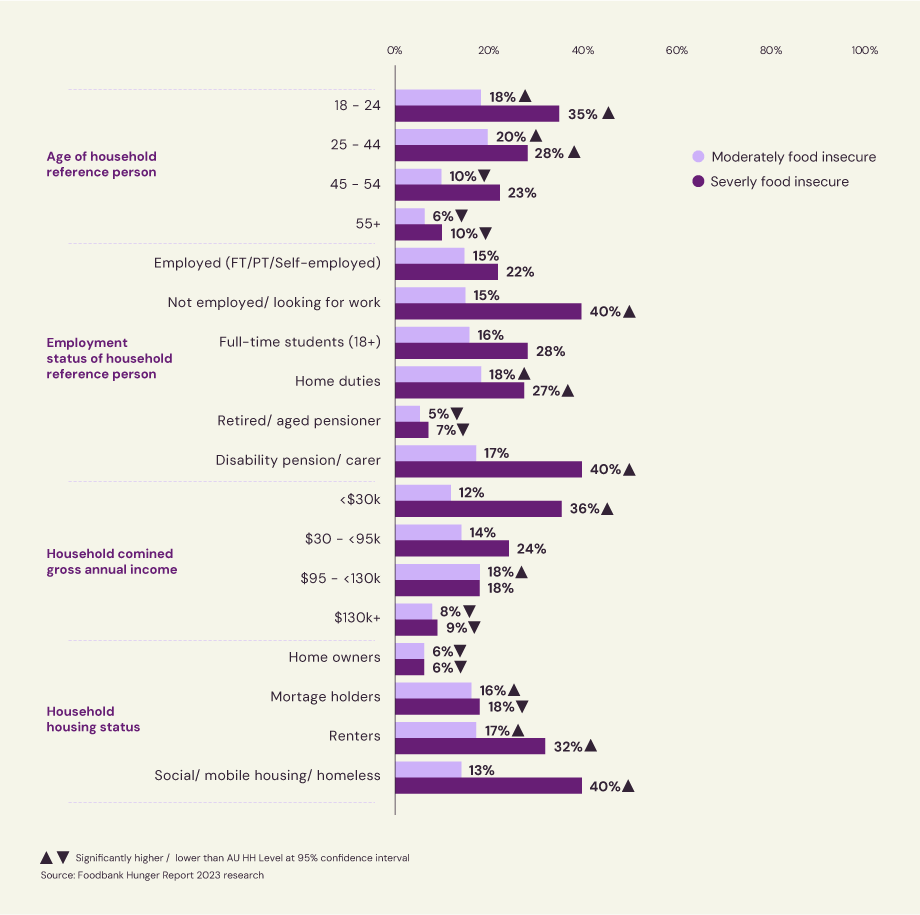
Close panel

The rising cost of living is tipping people over the edge
“It’s a combination of a number of factors. Being on aged pensions, taking in our granddaughter and great granddaughter due to family violence issues, depletion of any savings and using credit cards to pay for increased expenses like insurances, utilities and clothing.”
The cost of living is the most common reason for food insecurity in 2023
The majority of the Australian population (56%) reports that the cost-of-living crisis is by far their most important concern but for food insecure households, simple, everyday costs like food and housing are now overwhelming.
79% of food insecure households reported the rising cost-of-living as the biggest reason for their hardship. This is up significantly from 64% in 2022.
Reduced or low income/government benefits remain a significant contributor (42%) to food insecurity, as does a change in household /living arrangements (26%). Limited access or ability to travel to get food was a less significant contributor to food insecurity (16% vs 26% in 2022) likely due to the removal of the travel restrictions in place during the pandemic. Whilst the impact of natural disasters on food insecurity at the national level reduced in the last 12 months (8%, vs 19% in 2022), this factor was very variable at the local level and the forecast of a hot, dry 2023/24 summer is cause for concern.
The cost-of-living expenses crippling food insecure households
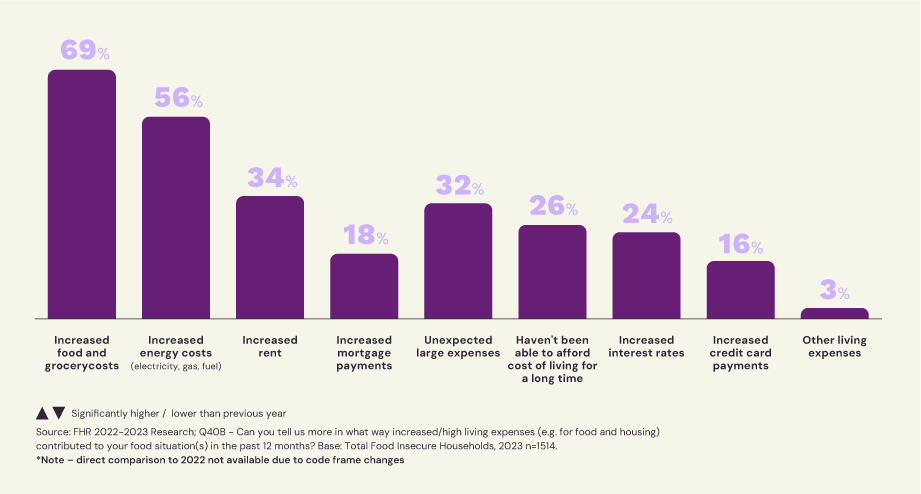
The cost of our most basic needs – food and shelter – is now the most common cause of food insecurity in Australia, with the cost of food and groceries reported as the chief contributor to food insecurity (69%), followed by energy costs (56%) and then housing costs (50%). Increasing rent (34%) is twice as likely to be cited as a factor compared to increasing mortgage repayments (18%).
Increased credit/debt repayments were cited by 16% of food insecure households as a contributing factor and this may climb further given the number of references made by people to resorting to Buy-Now-Pay-Later services for general expenses including food.
What we are seeing now contrasts markedly with the primary causes of food insecurity over the last decade – unexpected bills and expenses (32%) and not being able to afford the cost of living for a long time (26%). It is now everyday costs that are putting the pressure on households.
Close panel

Food is the most likely thing to be sacrificed to make ends meet
“We ran out of the basics like bread, fruit and milk. We managed to get some tinned food to get us through, but it wasn’t enough to help keep the kids full.”
Coping strategies to manage the cost of living
As one of the biggest contributors to the strain on household budgets, food and groceries are also the first items people cut back on when trying to make ends meet. 94% of food insecure households reported changing their shopping and eating out habits in the last 12 months. This included looking for sales/discounts on food and grocery items (71%), cutting back on meals out of the home (69%) and swapping foods for cheaper alternatives (59%). Nearly half (48%) of people reported reducing their purchasing of fresh produce and protein.
62% of food insecure households attempted to cope through changing their expenditure on their housing and finances including dipping into personal or household savings (42%) or deferring payments by spending more on credit cards or Buy-Now-Pay-Later services. 58% made savings by cutting back on their energy usage or changing plans, and 41% reduced their transport costs by driving less.
The spectrum of trade-offs when the money runs out

“I ordered bulk food from HelloFresh, split out the ingredients into different packets of food along the lines of basic food groups. I then mixed and matched various ingredients from the different packets at different times of the day to have different foods for say breakfast. Higher levels of nutrition at breakfast and lunch than dinner. After all, people sleep at night. The need for higher nutrition levels at night is lower than morning or lunch.”
(Male, 45-54, regional Victoria, self-employed)
“I got help from parents, they had me over for dinner more and gave me some food. I Afterpay groceries through DoorDash. I pre-make bulk batches of soup when I can afford the extra ingredients.”
(Female, 25-34, metro NSW, employed full-time)
“Focused on feeding the children and pets because although uncomfortable the adults could wait/eat less and by doing so the children and pets are unaware of the stressful situation.”
(Female, 24-34, metro SA, home duties)
“I worked Uber Eats to earn more money and get paid the same day [for food].”
(Male, 25-34, regional QLD, self-employed)
“Made sure my wife and son had enough to eat I choose to go without I didn’t let them know. I also picked up more hours at work.”
(Male, 25-34, regional NSW, employed full-time)
“I went hungry which caused an insulin overdose and had to be rushed to hospital. Luckily, I was able to get some food in hospital.”
(Male, 25-34, metro NSW, employed full-time)
“My wife and I just shared meals so there was plenty for the kids and we would only eat once a day.”
(Male, 45-54, metro NSW, employed full-time)
“Skipped meals, making large amounts in bulk when I do have enough for groceries and eating a large amount when I can to make up for skipped meals.”
(Female, 18-24, metro NSW, employed full-time)
“I just didn’t eat for 3 days and when I did eat I’d try to only eat small amounts to do my best to make the food last.”
(Female, 25-34, metro VIC, employed full-time)
Close panel

People are not seeking the help they need
“The last time I couldn’t afford enough food for the family, I just got creative in the kitchen for the kids and didn’t eat myself. I ate Milo and bikkies from the work staff room to tide me over.”
Despite the significant increase in the number of households experiencing food insecurity in the last 12 months, the proportion of those seeking help from formal food relief services (24%) and/or family and friends (31%) actually reduced (overall down to 44% from 58% in 2022). This is not altogether surprising given how many are experiencing food insecurity for the first time and, therefore, are not aware of the range of services available to them (65%) or feel embarrassed or ashamed of asking for help (45% vs 40% in 2022).
Barriers to people seeking formal food relief
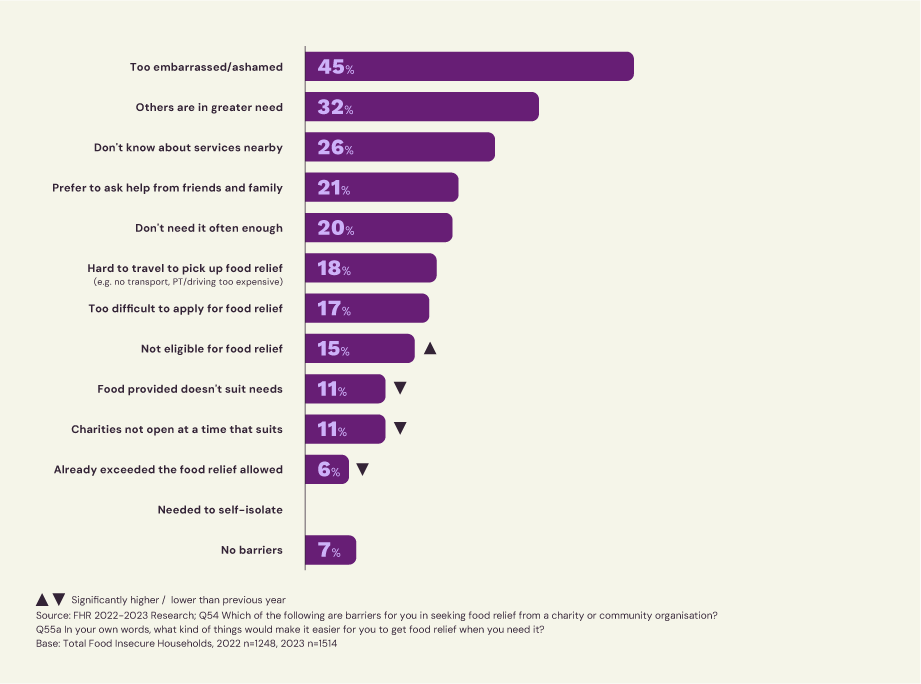
Close panel
Methodology
Read the details hereThis report presents key findings from the Foodbank Hunger Report 2023 research which was conducted between 12 and 31 July 2023, through an online survey of 4,342 Australians aged 18 years or older. The sample was nationally representative by age, gender and location (capital city / rest of state) in each major state, with stratified quotas to ensure all major states have a robust minimum sample size of n=600 or above.
All 4,342 Australians answered up to 18 questions in the United States Department of Agriculture Household Food Security Survey Module (HFSSM) for measurement of the prevalence of household food security over the 12 months ending July 2023.
A total of 1,514 respondents (36%) were identified through the HFSSM as being from moderately and severely food insecure households. This group continued to answer a deep dive module about their experience living with food insecurity over the last 12 months.
Close panel
Foodbank Australia would like to thank the following, without whom the Foodbank Hunger Report would not be possible:
The individuals who shared their lived experience in the Foodbank Hunger Report Survey, providing insights into the challenges they face in meeting their daily food needs. Please note all images associated with quotes are stock photos.
The hard-working state and territory Foodbanks who are always prepared to take time from their vital work to respond to our requests for feedback and on-the-ground intelligence and observations.
IPSOS for undertaking the Foodbank Hunger Report Survey and providing detailed analysis of this and other sources of data to provide the basis for this report.
Russell Moverley for the design of the report.
TBST Digital for the development of the report website.
The Australian Government Department of Agriculture, Water and Environments’ financial contribution via the Fight Food Waste Cooperative Research Centre project: Enhancing Foodbank’s stakeholder engagement.
This report may be quoted for the purposes of research, discussion, record keeping, educational use and other public benefit, provided that such reproduction acknowledges Foodbank Australia.
Foodbank Australia Limited
ABN 58 073 579 254 +61 2 9887 4144 admin@foodbank.org.au foodbank.org.au
Facebook: https://www.facebook.com/FoodbankAus
Twitter: https://twitter.com/FoodbankAus
LinkedIn: https://au.linkedin.com/company/foodbank-australia
Instagram: https://www.instagram.com/foodbankaus
Close panel
